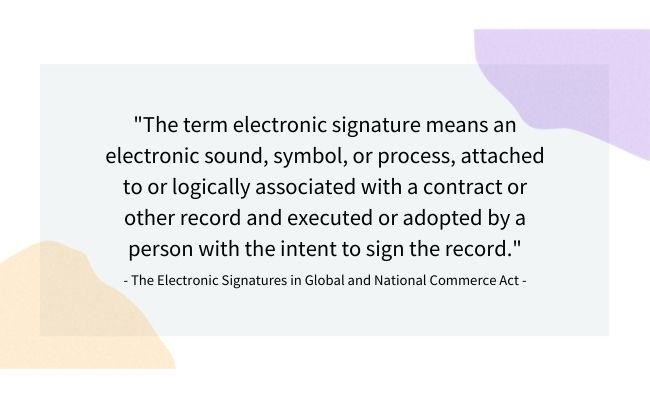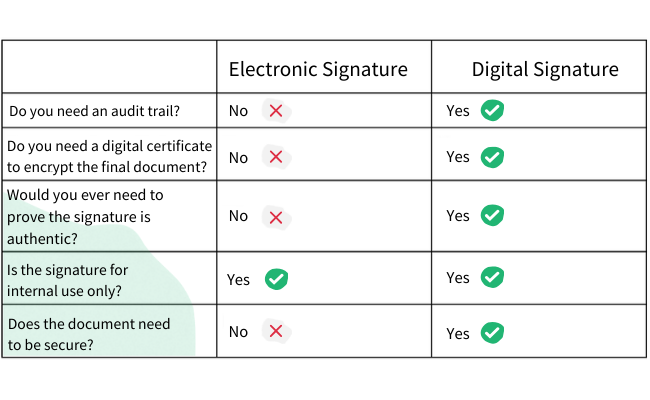Post last updated 2/17/2022
If your business needs to collect signatures to do business, it’s important to understand the difference between electronic signatures and digital signatures. Knowing what types of signatures your business needs to collect impacts the technology and processes you need to implement.
Although they may sound the same, electronic signatures and digital signatures are different in many ways. Who knew the world of signatures could be so confusing?
We’re here to break down the differences between electronic and digital signatures so you can choose what is right for your business. Read on to learn more about each type of signature and when to use them.
The following information is not official legal advice. For expert guidance on legal matters, you’ll need to consult an attorney. However, if you’re just looking for some need-to-know basics on electronic signatures, these details will help get you up to speed quickly.
Electronic Signatures
Oxford Languages defines an electronic signature as symbols or other data in digital form attached to an electronically transmitted document as verification of the sender’s intent to sign the document.
What is an electronic signature?
An electronic signature acts as an acceptance or approval of the contents within a document or form. All that is needed for an electronic signature is a mark, which can be captured through a check box, typed name, electronically signed name, or uploaded signature image. Electronic signatures reveal the intent by the signer to sign the document.

Benefits of Electronic Signatures
Electronic signatures can benefit your business in many ways. They make gathering signatures easier, faster, and more efficient when compared to using pen and paper. It saves you time and money by avoiding the need to print, sign, scan, or mail your documents and forms.
Here are some cases where people use Formstack to gather electronic signatures:
- Accident Reports
- Checklist Sign Offs
- Enrollment Forms
- Employee Reviews
- Internal Approvals
- Internal Evaluations
- Patient Registration
Are electronic signatures legally binding?
Electronic signatures have carried the same legal weight as traditional, paper-based ones since the United States Electronic Signatures in Global and National Commerce Act (ESIGN) was passed in 2000. This legislation ensures that electronic signatures are legally binding in every state where federal law applies.
Where federal law does not apply, most states have adopted the Uniform Electronic Transactions Act (UETA). Developed by the Uniform Law Commission, UETA provides a legal framework for the use of electronic signatures and helps ensure they are just as enforceable as their paper counterparts.
For more information on the legality of electronic signatures, please read our article Are Electronic Signatures Legally Binding?
Here’s how electronic signatures fall short.
Electronic signatures are just that: a pen and paper signature captured electronically. Because of this, there is not an authentication process that verifies the signee or document. What separates digital signatures from electronic signatures is the way digital signatures use a digital certificate to encrypt the final signed document. This includes evidence of the signer identify via unique link sent via email, SMS, shared password between the sender and a signer, or a similar method.
Digital Signatures
Oxford Languages defines a digital signature as a type of electronic signature that encrypts documents with digital codes that are particularly difficult to duplicate.
What is a digital signature?
A digital signature is a type of electronic signature process that uses an encrypted digital certificate to make the document tamper-evident which can be verified with it’s public key, created upon signing. The process creates an audit trail, which provides details on each step taken to sign the document. Digital signatures are sometimes referred to as advanced electronic signatures, qualified electronic signatures, or other terms in jurisdictions outside the United States.
What makes a digital signature different from an electronic signature?
A digital signature is an electronic signature captured through an eSignature software using special encryption. This cryptographic operation creates a digital “fingerprint” for each document sent for signing. This provides better security by ensuring the document can not be altered. It also verifies the signees of a document, protecting your organization from fraud.
How do digital signatures work?
Digital signatures use a specific encryption process to protect and authenticate the document by using “Personal Key Infrastructure” (PKI). PKIs identify, verify, and authenticate each party signing a document. Consider this system as a digital notary for the signing of your document. It enables secure tracking and protection of your documents.
For example, Formstack Sign runs all signed documents through GlobalSign to create a digital certificate for each document. The certificate links the signee to the document, enabling an audit trail. This proves the authenticity of the document, its source, and the signee.
Benefits of Digital Signatures
Digital signatures provide a more secure process for gathering electronic signatures. Thanks to top-level encryption, digital signatures can authenticate the document and signees, providing a layer of protection above a more general electronic signature. Digital signatures are recommended for those in highly regulated industries, such as insurance, real estate, and financial services.
Here are some cases where people use Formstack Sign to gather digital signatures:
Formstack Sign also comes loaded with excellent features that can help your organization streamline processes and improve workflows. From signature templates to auto-reminders, there are many useful tools inside our eSignature product. It also provides top-tier security and compliance features, like audit trails, FDA compliance, and HIPAA compliance.

Which do you need: a digital signature or electronic signature?
Certain situations call for a digital signature versus an electronic signature. The list below provides insight into which option to use depending on your needs. Please note that many eSignature solutions provide a digital signature. We recommend connecting with your legal counsel on what type of signature is best, since this can depend on your country, industry, and document type.

Discover signature products that fit your needs.
If you need a way to quickly and easily gather signatures, Formstack has you covered! If you’re looking for a simple way to gather signatures, Formstack’s online forms paired with the signature field are a great solution. Use our drag-and-drop form builder to easily create forms-driven workflows without needing a single line of code.
In need of a more official digital signature? Formstack Sign provides the features you need to securely gather authenticated signatures in minutes. Whether you’re sending out contracts, sharing patient information, or gathering signatures on financial documents, Sign provides an easy user interface with top-notch security.
Want to give Formstack Sign a try? Start your free 14-day trial now to see this industry-leading eSignature product in action!











